|
|
| (8 intermediate revisions by 7 users not shown) |
| Line 1: |
Line 1: |
| | {{HTML}} |
| | |
| The '''Clan Scholae Palatinae Titles of Nobility''' are clan-privileged titles which may be held for the duration of one's lifetime. These titles are meant to relay that one is "known" or "notable", and applies to the highest social class one can attain within the [[Cocytus System]]. They are awarded strictly for service unto the [[Clan]] and granted by the hand of the residing [[Consul]]. | | The '''Clan Scholae Palatinae Titles of Nobility''' are clan-privileged titles which may be held for the duration of one's lifetime. These titles are meant to relay that one is "known" or "notable", and applies to the highest social class one can attain within the [[Cocytus System]]. They are awarded strictly for service unto the [[Clan]] and granted by the hand of the residing [[Consul]]. |
|
| |
|
| Line 15: |
Line 17: |
| The titles would be derived from the culture of Judecca itself, spanning across the entire system - known to all of Cocytus. Following the model of other systems of nobility, the Emperor resides as the King of Kings. And beneath him are the vassal Kings and Queens whom rule the planets and their militas. Of a different nature, and breaking from the norm, is that the next-in-line is the would-be Prince or Princess; whom outweighs the political clout of a Grand Duke as they are the natural successor to the King or Queen. However, should no Prince or Princess be in line for the throne a Grand Duke may assume the mantle with the Emperor's leave. Another point of contention - in some circles - is the rank of Archduke, placed below that of the Grand Duke. While, normally, equivalent titles, the culture of Judecca established a degree of difference between these titles during their long, hard-fought history. | | The titles would be derived from the culture of Judecca itself, spanning across the entire system - known to all of Cocytus. Following the model of other systems of nobility, the Emperor resides as the King of Kings. And beneath him are the vassal Kings and Queens whom rule the planets and their militas. Of a different nature, and breaking from the norm, is that the next-in-line is the would-be Prince or Princess; whom outweighs the political clout of a Grand Duke as they are the natural successor to the King or Queen. However, should no Prince or Princess be in line for the throne a Grand Duke may assume the mantle with the Emperor's leave. Another point of contention - in some circles - is the rank of Archduke, placed below that of the Grand Duke. While, normally, equivalent titles, the culture of Judecca established a degree of difference between these titles during their long, hard-fought history. |
|
| |
|
| Those whom were proclaimed Grand Dukes - a rival warring faction - met the Archduke's forces - of a rival faction - in fierce battle where the Grand Dukes proved superior. It was this point, in Judeccan history, that a definitive difference would come to be between the titles. From this point, the titles would be straight-forward as the next ranks would be Duke, then Marquess, followed by the Counts - and their lessers, the Viscounts - before one reached the initial rank of entrance within the Cocytus System: Baron or Baroness. | | Those whom were proclaimed Grand Dukes - a rival warring faction - met the Archduke's forces - of a rival faction - in fierce battle where the Grand Dukes proved superior. It was this point, in Judeccan history, that a definitive difference would come to be between the titles. From this point, the titles would be straightforward as the next ranks would be Duke, then Marquess, followed by the Counts - and their lessers, the Viscounts - before one reached the initial rank of entrance within the Cocytus System: Baron or Baroness. |
|
| |
|
|
| |
|
| Line 61: |
Line 63: |
| The program is to be ran, and maintained, by the [[Clan Summit]] of Scholae Palatinae; however, they may direct another individual to speak on their behalf. Ultimately, however, the Consul resides as the sole authority on the distribution of points. Which events, and the values assigned to them, will be identified by the Clan Summit previous to the event running. Additionally, these events may range from in-Clan to Brotherhood-wide events; meaning [[Vendetta|Vendettas]], Clan competitions and House Feuds are eligible for consideration. Once an event is concluded, the Clan Summit will track the participation of the members of the Clan and reward, or update, their point totals accordingly. Last, but not least, the Clan Summit must approve all changes, or additions, to the program before they may be executed. | | The program is to be ran, and maintained, by the [[Clan Summit]] of Scholae Palatinae; however, they may direct another individual to speak on their behalf. Ultimately, however, the Consul resides as the sole authority on the distribution of points. Which events, and the values assigned to them, will be identified by the Clan Summit previous to the event running. Additionally, these events may range from in-Clan to Brotherhood-wide events; meaning [[Vendetta|Vendettas]], Clan competitions and House Feuds are eligible for consideration. Once an event is concluded, the Clan Summit will track the participation of the members of the Clan and reward, or update, their point totals accordingly. Last, but not least, the Clan Summit must approve all changes, or additions, to the program before they may be executed. |
|
| |
|
| Eligibility is based on two prerequisites: must be a member of Clan Scholae Palatinae and have, at the minimum, attained the rank of Dark Knight. On January 5, 2008, the Clan Summit provided a fair initiation program to reward every member from Dark Jedi Knight to [[Dark Prophet]] for their past service. Nowadays, points are earned through participation to brotherhood events and general activity with in the clan using a system designed by [[Impetus|Impetus M'Nar]]. While members below DJK are not eligible for the merit systemm, their points will be tracked anyway. | | Eligibility is based on two prerequisites: must be a member of Clan Scholae Palatinae and have, at the minimum, attained the rank of Dark Knight. On January 5, 2008, the Clan Summit provided a fair initiation program to reward every member from Dark Jedi Knight to [[EL3|Dark Prophet]] for their past service. Nowadays, points are earned through participation to brotherhood events and general activity with in the clan using a system designed by [[Impetus|Impetus M'Nar]]. While members below DJK are not eligible for the merit systemm, their points will be tracked anyway. |
| | |
|
| |
|
| ==== Points ==== | | ==== Points ==== |
| Line 117: |
Line 118: |
| <tr> | | <tr> |
| <td>Competition hosting</td> | | <td>Competition hosting</td> |
| <td>2 + 1 for every particpant | | <td>2 + 1 for every participant |
| </td> | | </td> |
| </tr> | | </tr> |
| Line 239: |
Line 240: |
| [[File:Krath_Cloak_(CSP_Nobility).jpg|thumb|200px|left|Cloak and Clasp of Acclivis Draco]] | | [[File:Krath_Cloak_(CSP_Nobility).jpg|thumb|200px|left|Cloak and Clasp of Acclivis Draco]] |
| '''House Acclivis Draco:''' | | '''House Acclivis Draco:''' |
| A dark black exterior, or outer shell, of fine material that flows from shoulder to shin… the Cloak of [[Acclivis Draco]] is trimmed in an one inch border of black silk; adding a majestic, flowing sensation to the already extraordinary look. The inner lining is that of a deep amethyst, reflecting the House’s relationship with their Krath heritage. The last piece is a clasp of silver that represents the House by it’s symbol: the dragon. | | A dark black exterior, or outer shell, of fine material that flows from shoulder to shin… the Cloak of [[Acclivis Draco]] is trimmed in an one inch border of black silk; adding a majestic, flowing sensation to the already extraordinary look. The inner lining is that of a deep amethyst, reflecting the House’s relationship with their Krath heritage. The last piece is a clasp of silver that represents the House by its symbol: the dragon. |
|
| |
|
|
| |
|
| [[File:Sith_Cloak_(CSP_Nobility).jpg|thumb|200px|right|Cloak and Clasp of Caliburnus]] | | [[File:Sith_Cloak_(CSP_Nobility).jpg|thumb|200px|right|Cloak and Clasp of Caliburnus]] |
| '''House Caliburnus:''' | | '''House Caliburnus:''' |
| A dark black exterior, or outer shell, of fine material that flows from shoulder to shin… the Cloak of [[Caliburnus]] is trimmed in a one inch border of black silk. Adding a majestic, flowing sensation to the already extraordinary look. The inner lining is that of a deep crimson, reflecting the House’s relationship with their Sith heritage. The last piece is a clasp of silver that represents the House by it’s symbol: the sword. | | A dark black exterior, or outer shell, of fine material that flows from shoulder to shin… the Cloak of [[Caliburnus]] is trimmed in a one inch border of black silk. Adding a majestic, flowing sensation to the already extraordinary look. The inner lining is that of a deep crimson, reflecting the House’s relationship with their Sith heritage. The last piece is a clasp of silver that represents the House by its symbol: the sword. |
|
| |
|
|
| |
|
| [[File:Obelisk_Cloak_(CSP_Nobility).jpg|thumb|200px|left|Cloak and Clasp of Dorimad Sol]] | | [[File:Obelisk_Cloak_(CSP_Nobility).jpg|thumb|200px|left|Cloak and Clasp of Dorimad Sol]] |
| '''House Dorimad Sol:''' | | '''House Dorimad Sol:''' |
| A dark black exterior, or outer shell, of fine material that flows from shoulder to shin… the Cloak of [[Dorimad Sol]] is trimmed in a one inch border of black silk. Adding a majestic, flowing sensation to the already extraordinary look. The inner lining is that of a deep sapphire, reflecting the House’s relationship with their Obelisk heritage. The last piece is a clasp of silver that represents the House by it’s symbol: the sun. | | A dark black exterior, or outer shell, of fine material that flows from shoulder to shin… the Cloak of [[Dorimad Sol]] is trimmed in a one inch border of black silk. Adding a majestic, flowing sensation to the already extraordinary look. The inner lining is that of a deep sapphire, reflecting the House’s relationship with their Obelisk heritage. The last piece is a clasp of silver that represents the House by its symbol: the sun. |
|
| |
|
|
| |
|
| Line 360: |
Line 361: |
| '''Stronghold:''' A stronghold is often considered a mansion, but with a more secure defensive perimeter. It was often practiced to build a wall about one’s mansion, or home, to create a defensible perimeter - this was first practiced by stacking logs horizontally to an approximate height of ten feet. Later there would be adjustments that included spiked tops, barbed wire, and walkways for archers. While not as regal looking, it offers more protection than those below it. | | '''Stronghold:''' A stronghold is often considered a mansion, but with a more secure defensive perimeter. It was often practiced to build a wall about one’s mansion, or home, to create a defensible perimeter - this was first practiced by stacking logs horizontally to an approximate height of ten feet. Later there would be adjustments that included spiked tops, barbed wire, and walkways for archers. While not as regal looking, it offers more protection than those below it. |
|
| |
|
| '''Castle:''' A castle or military keep, was invented as a fortification not only for an individual, but those citizens aligned to a Noble. Some Castles will have either a Regal home or keep at it’s center, sturdy homes for it’s citizens and fortified walls to create a defense. Most of these structures are quite sturdy and will last through centuries of use and war. No two Castles will look alike, but each will remain a defensive strongpoint to a Noble’s base of power. | | '''Castle:''' A castle or military keep, was invented as a fortification not only for an individual, but those citizens aligned to a Noble. Some Castles will have either a Regal home or keep at its center, sturdy homes for it’s citizens and fortified walls to create a defense. Most of these structures are quite sturdy and will last through centuries of use and war. No two Castles will look alike, but each will remain a defensive strongpoint to a Noble’s base of power. |
|
| |
|
| '''Citadel:''' A citadel is a fortress for protecting a town, sometimes with a castle in its middle. The term derives from the same Latin root as the word "city", civis, meaning citizen. | | '''Citadel:''' A citadel is a fortress for protecting a town, sometimes with a castle in its middle. The term derives from the same Latin root as the word "city", civis, meaning citizen. |
| Line 409: |
Line 410: |
| <td> 3160 </td> | | <td> 3160 </td> |
| <td> Ric "Blade" Korbain </td> | | <td> Ric "Blade" Korbain </td> |
| <td> Marquess & Judge </td> | | <td> Marquess & Judge </td> |
| <td> 463 | | <td> 463 |
| </td> | | </td> |
| Line 507: |
Line 508: |
| <td> 8307 </td> | | <td> 8307 </td> |
| <td> Kalak Ragnose </td> | | <td> Kalak Ragnose </td> |
| <td> Count & Judge </td> | | <td> Count & Judge </td> |
| <td> 260 | | <td> 260 |
| </td> | | </td> |
| Line 521: |
Line 522: |
| <td> 8955 </td> | | <td> 8955 </td> |
| <td> Angelo Dante </td> | | <td> Angelo Dante </td> |
| <td> Duke & Grand Marshal </td> | | <td> Duke & Grand Marshal </td> |
| <td> 738 | | <td> 738 |
| </td> | | </td> |
| Line 729: |
Line 730: |
| <td> 3155 </td> | | <td> 3155 </td> |
| <td> Lambow (Timbal) </td> | | <td> Lambow (Timbal) </td> |
| <td> Count & Surface Marshal </td> | | <td> Count & Surface Marshal </td> |
| <td> 257 | | <td> 257 |
| </td> | | </td> |
| Line 839: |
Line 840: |
| </tr> | | </tr> |
| </table> | | </table> |
| <table width="98%" align="left" cellpadding="3" cellspacing="2" style="border: 1px #642366 solid; background: #000000;-moz-background-clip: initial; -moz-background-origin: initial; -moz-background-inline-policy: initial; -moz-border-radius-topleft: 1em; -moz-border-radius-bottomleft: 1em; -moz-border-radius-topright: 1em; -moz-border-radius-bottomright: 1em; width: 200; margin-top: -1.4em; margin: 0 0 1em 1em; font-family: Arial, Helvetica, sans-serif; font-size: 10px;color: #ffffff;">
| |
| <tr><td colspan="2" style="-moz-border-radius-topleft: 1em; -moz-border-radius-topright: 1em; text-align: center; color: #ffffff; font-variant:small-caps; font-size:larger; background-color: #4C2471; text-align:center;"> '''House Scholae Palatinae'''
| |
| </td></tr>
| |
| <tr>
| |
| <td style="background: #3E2F54; padding-left:6px; padding-right:6px; color: #ffffff; text-align:center" width="150px"> '''Units'''
| |
| </td>
| |
| <td style="background: #222222; padding-left:6px; padding-right:6px; color: #ffffff; text-align:left"> [[Scholae Palatinae]] • [[Acclivis Draco]] • [[Dorimad Sol]] • [[Caliburnus]] • [[Nightstalkers]]
| |
| </td>
| |
| </tr>
| |
| <tr>
| |
| <td style="background: #3E2F54; padding-left:6px; padding-right:6px; color: #ffffff; text-align:center" width="150px"> '''Leadership'''
| |
| </td>
| |
| <td style="background: #222222; padding-left:6px; padding-right:6px; color: #ffffff; text-align:left"> '''Summit:''' [[Ood Bnar Sythe'rae]] • [[Xen'Mordin Vismorsus]] • [[Kalak Ragnose]]
| |
|
| |
|
| '''BAD:''' [[Koryn Thraagus]]
| | [[Category:Historic_Scholae_Palatinae_Articles]] |
| | |
| '''BDS:''' [[Erianna "Rayne" Victae]]
| |
| | |
| '''BCL:''' [[Impetus M'Nar]]
| |
| | |
| '''BNS:''' [[Angelo Dante]]
| |
| </td>
| |
| </tr>
| |
| <tr>
| |
| <td style="background: #3E2F54; padding-left:6px; padding-right:6px; color: #ffffff; text-align:center" width="150px"> '''Possessions'''
| |
| </td>
| |
| <td style="background: #222222; padding-left:6px; padding-right:6px; color: #ffffff; text-align:left"> [[Cocytus System]] • [[Category:Scholae Palatinae OOB]] • [[Scholae Palatinae Military|Military]] • [[Category:Scholae Palatinae Vault]]
| |
| </td>
| |
| </tr>
| |
| <tr>
| |
| <td style="background: #3E2F54; padding-left:6px; padding-right:6px; color: #ffffff; text-align:center" width="150px"> '''Miscellaneous'''
| |
| </td>
| |
| <td style="background: #222222; padding-left:6px; padding-right:6px; color: #ffffff; text-align:left"> [[Scholae Palatinae Prospectus|House Prospectus]] • [[Children of Palpatine]] • [[Scholae Palatinae#House_Force_Powers|House Force Powers]]
| |
| </td>
| |
| </tr>
| |
| <tr><td bgcolor="#53855C;" colspan="3" align="center" style="-moz-border-radius-bottomleft: 1em; -moz-border-radius-bottomright: 1em; text-align: center; background-color: #4C2471; color: #4FBD52; font-size:smaller;">
| |
| [[Category:Scholae Palatinae]] | |

|
You've got the wrong table! This article or template is using HTML tables rather than wiki markup.
Please convert any HTML into wiki markup before removing this tag.
|
The Clan Scholae Palatinae Titles of Nobility are clan-privileged titles which may be held for the duration of one's lifetime. These titles are meant to relay that one is "known" or "notable", and applies to the highest social class one can attain within the Cocytus System. They are awarded strictly for service unto the Clan and granted by the hand of the residing Consul.
History
Origin
As the Dark Brotherhood has planted itself in the hierarchy of their current residences and amassed power and wealth, they have done so with great secrecy. However, with a legitimate force at their backs, and more and more people flocking to their banners, they have begun to utilize their wealth upon the surfaces of their home worlds. Most of the members are abandoning their impoverished standards and accepting lives of aristocracy, in addition to their Brotherhood standing. These individuals have been declared Nobles of Clan Scholae Palatinae and bequeathed upon them are titles, awards, riches, and landholdings.
The realization that these titles would need to be distributed by the residing Consul of the Clan would come to the first Tyrant, Dakari the Merciless. Under his steady supervision, with the assistance of his Proconsul, he would develop several models in which to distribute the wealth of the Royal Clan; however, no design would successfully work during his tenure. With his retirement from the seat of power, he would pass the project onto his successor, Braecen Kaeth. The project would take a similar course under Braecen's supervision, with the assistance of his Proconsul, where they would finalize the basics of the program and begin adding more flavor and detail to those whom were granted Titles of Nobility. The program would even launch during this Consul and Proconsul's tenure, but it would not last. Overcome with more pressing issues and unsure of the program's direction, it would be disbanded.
When Phoenix Olkyssagh d'Tana Palpatine took the reigns of the Clan from his predecessor, he would revitalize the idea with his Proconsul, Lucien Kaeth. Working with both previous Consuls, the quartet - with the assistance of many others - would finalize a program where those whom had labored for the Clan would be rewarded with its riches. And so, it would pass in the twenty-eighth year after the Battle of Yavin, that the first Patents of Nobility would be issued to those whom held the rank of Dark Knight or higher.
Derivation
The titles would be derived from the culture of Judecca itself, spanning across the entire system - known to all of Cocytus. Following the model of other systems of nobility, the Emperor resides as the King of Kings. And beneath him are the vassal Kings and Queens whom rule the planets and their militas. Of a different nature, and breaking from the norm, is that the next-in-line is the would-be Prince or Princess; whom outweighs the political clout of a Grand Duke as they are the natural successor to the King or Queen. However, should no Prince or Princess be in line for the throne a Grand Duke may assume the mantle with the Emperor's leave. Another point of contention - in some circles - is the rank of Archduke, placed below that of the Grand Duke. While, normally, equivalent titles, the culture of Judecca established a degree of difference between these titles during their long, hard-fought history.
Those whom were proclaimed Grand Dukes - a rival warring faction - met the Archduke's forces - of a rival faction - in fierce battle where the Grand Dukes proved superior. It was this point, in Judeccan history, that a definitive difference would come to be between the titles. From this point, the titles would be straightforward as the next ranks would be Duke, then Marquess, followed by the Counts - and their lessers, the Viscounts - before one reached the initial rank of entrance within the Cocytus System: Baron or Baroness.
Priesthood of Lore
Priesthood of Lore
As Scholae Palatinae continued to develop in multiple areas under the reign of Consul Phoenix, it became rather clear that adding the maintenance of the clan's nobility to the list of duties of the clan summit would be a waste of time compared to some other plans, most notably a conflict that would become a full scale war between the clans of Scholae Palatinae, Arcona and Plagueis.
Given the ever increasing business of both the Clan and House summits, a Head of Nobility was appointed who was not a member of either. Phoenix created the Priesthood of Lore and made Impetus M'Nar it’s first Priestess. She was granted the title of Duchess, and would be the one responsible for keeping track of the activity of the Nobles, and assigning new titles when necessary. This duty was originally done by the Ward of the South amongst other things, but the other wards were not fulfilling their duties and so the Wards were disbanded.
The Priesthood of Lore position, like the nobility derives from Judeccan Culture. When someone was made an Emperor or a King, an individual whose title has been lost in history would be called upon to coronate them in an official ceremony. Other rituals were created for the lower echelons of the Nobility. The Priest would be granted free movement through all of Judecca and none of the tribes would attach him, such was the respect they held for the position. When the modern Priesthood was created, the Priest held the same basic duties as in the old days. However, a Deacon was also created, the intention being to lighten the workload a little and bring fresh ideas in. The Deacon would eventually take over the Priest’s job at his resignation.
Impetus also revolutionised the system, bringing in a new points system that awarded clan contribution fairer and more evenly than it was before. She also started the tradition of allowing past prominent members to keep their titles as a mark of respect for their role in shaping the clan even after they had left Scholae Palatinae, however, nobles would only be permitted to keep their titles, residence and noble belongings if they left the clan in a respectful manner, as judged by the Priest of Lore.
In 30 ABY, Impetus departed the Clan and Kalak Ragnose took over as Priest of Lore. Yeldarb Vohokou has been chosen as the new Deacon of Lore.
Overview
Inner Workings
The Nobility System was created as a means of rewarding not only those whom were submitting to competitions, but as a standard to ensure that the lifeblood of any group would remain: activity. To stimulate activity, or rather, people’s desire to remain active to their immediate group, a system must be in place that recognizes their efforts. It is not a system meant to track members whom just participated in competitions, but all forms of activity - directed by the Clan Summit - a system to reward anyone who works to benefit the whole; points for participation and dedication.
Eligibility & Administration
The program is to be ran, and maintained, by the Clan Summit of Scholae Palatinae; however, they may direct another individual to speak on their behalf. Ultimately, however, the Consul resides as the sole authority on the distribution of points. Which events, and the values assigned to them, will be identified by the Clan Summit previous to the event running. Additionally, these events may range from in-Clan to Brotherhood-wide events; meaning Vendettas, Clan competitions and House Feuds are eligible for consideration. Once an event is concluded, the Clan Summit will track the participation of the members of the Clan and reward, or update, their point totals accordingly. Last, but not least, the Clan Summit must approve all changes, or additions, to the program before they may be executed.
Eligibility is based on two prerequisites: must be a member of Clan Scholae Palatinae and have, at the minimum, attained the rank of Dark Knight. On January 5, 2008, the Clan Summit provided a fair initiation program to reward every member from Dark Jedi Knight to Dark Prophet for their past service. Nowadays, points are earned through participation to brotherhood events and general activity with in the clan using a system designed by Impetus M'Nar. While members below DJK are not eligible for the merit systemm, their points will be tracked anyway.
Points
A total tally will always be maintained to calculate a Noble’s rank. These numbers will determine what status a Noble maintains and will dictate an individual’s rank, holdings, and honor guard. This number is maintained by the Priesthood, and tallied daily. The following table shows how one may earn points in the nobility system.
Notice:
Points awarded from Vendettas will not follow the system below, they will have their own separate scoring formula.
Also, of immediate effect, points will only be awarded for fiction, poetry, graphics, trivia, and any other competition type requiring a level of work deemed satisfactory by the Priest of Lore. This applies to both entrants and hosts.
| Activity |
Points
|
| Assisting Leadership/Wardship |
Variable
|
| 1st Level Crescent Competition |
14
|
| 2nd Level Crescent Competition |
10
|
| 3rd Level Crescent Competition |
6
|
| 4th Level Crescent Competition |
4
|
| 5th Level Crescent Competition |
2
|
| Trivia Participation |
2
|
| Competition hosting |
2 + 1 for every participant
|
| Pendant of Blood |
10
|
| Scroll of Indoctrination |
6
|
| Scroll of Foundation |
10
|
| Gold Nova |
12
|
| Silver Nova |
10
|
| Bronze Nova |
8
|
| Every 5 clusters of fire |
1
|
Ranks, Rewards & Standards
Ranks of Nobility
Baron/Baroness [0 points required]
Viscount [100 points required]
- Granted the right to wear the cloak and clasp of corresponding House
- Awarded an honor guard of one soldier
- Awarded a parcel
Count/Countess [200 points required]
- Granted the right to wear the bracers of the Clan
- Awarded an honor guard of two soldiers
- Awarded a Villa
Marquess/Marchioness [300 points required]
- Granted the right to wear the ring of corresponding Order
- Awarded an honor guard of three soldiers
- Awarded a Mansion
Duke/Duchess [500 points required]
- Granted the right to wear a shield of the Clan
- Awarded an honor guard of four soldiers
- Awarded a Stronghold
Archduke/Archduchess [800 points required]
- Granted the right to wear the sword of the Clan
- Awarded an honor guard of eight soldiers
- Awarded a Castle
Grand Duke/Grand Duchess [1300 points required]
- Granted the right to wear the armor of the Clan
- Awarded an honor guard of twelve soldiers
- Sector Governor
Prince/Princess [2000 points required]
- Granted the right to wear the helm of corresponding Order
- Awarded an honor guard of sixteen soldiers
- Awarded a Citadel
King/Queen [3000 points required]
- Awarded an honor guard of twenty soldiers.
- Planetary Governor and Militia Commander
Ranks of Command
Surface Marshal [Quaestor]
- Awarded an honor guard of one Imperial Sentinel
- Commander of a Regiment
- Planetary Lieutenant Governor
Grand Marshal [Proconsul]
- Awarded an honor guard of two Imperial Sentinels
- Commander of Clan Military Forces
- Eligible for rank of Archduke/Archduchess upon retirement/resignation
Emperor [Consul]
- Awarded an honor guard of three Imperial Sentinels
- System Governor and Clan Overlord
- Eligible for rank of Grand Duke/Duchess upon retirement/resignation
Armory
Cloak and Clasp
While each House is represented by their own standard or emblem, it is also the basis of every member’s identity and tradition. Thus, the first item attained will reflect the relationship one has with their present House. Normally the cloak will be formatted in some design with only two colors present. The clasp, however, may be extremely decorative, ornate, and symbolic of the House, as it will be the main piece that catches the eyes of those whom they come in contact with.
 Cloak and Clasp of Acclivis Draco
Cloak and Clasp of Acclivis Draco
House Acclivis Draco:
A dark black exterior, or outer shell, of fine material that flows from shoulder to shin… the Cloak of Acclivis Draco is trimmed in an one inch border of black silk; adding a majestic, flowing sensation to the already extraordinary look. The inner lining is that of a deep amethyst, reflecting the House’s relationship with their Krath heritage. The last piece is a clasp of silver that represents the House by its symbol: the dragon.
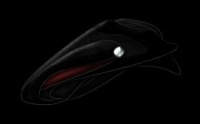 Cloak and Clasp of Caliburnus
Cloak and Clasp of Caliburnus
House Caliburnus:
A dark black exterior, or outer shell, of fine material that flows from shoulder to shin… the Cloak of Caliburnus is trimmed in a one inch border of black silk. Adding a majestic, flowing sensation to the already extraordinary look. The inner lining is that of a deep crimson, reflecting the House’s relationship with their Sith heritage. The last piece is a clasp of silver that represents the House by its symbol: the sword.
 Cloak and Clasp of Dorimad Sol
Cloak and Clasp of Dorimad Sol
House Dorimad Sol:
A dark black exterior, or outer shell, of fine material that flows from shoulder to shin… the Cloak of Dorimad Sol is trimmed in a one inch border of black silk. Adding a majestic, flowing sensation to the already extraordinary look. The inner lining is that of a deep sapphire, reflecting the House’s relationship with their Obelisk heritage. The last piece is a clasp of silver that represents the House by its symbol: the sun.
Bracers
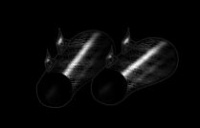 Bracers of Scholae Palatinae
Bracers of Scholae Palatinae
The Clan is the mother of its Houses, often finding its inspiration or drive from the active hives - the Houses - of membership. But it should be noted that members whom drive a House often drive a Clan towards a positive direction; thus creating a symbiotic relationship between the two. The Clan becomes a protective outer shell, thus the Bracers of a noble reflect this member's relation to the Clan.
This protective strap, fashioned along the forearm of the wearer, is made from metal. The density is high, creating minimal restrictions against movement, but the wearer is granted a sleek metal guard against blaster fire and errant swords. The black metal fits together at grooves that interlock upon the forearm; for additional defense the Bracers of Scholae Palatinae have small jutting wings to catch a sword upon or leash an attack against an opponent.
Ring
 Ring of the CSP Krath
Ring of the CSP Krath
Regardless of House and Clan, a member will often find themselves split fictionally and interests-wise, sometimes, by their corresponding Order. While there are only three, each represents a differing path in the triumvirate and offers their own leaderships, competitions and identity. To represent one’s undying loyalty they might wear the symbol of their Order upon hand: the ring of an Order.
 Ring of the CSP Sith
Ring of the CSP Sith
Krath Order:
A silver band or circle is the base of the unique Order gift. Upon the precious metal base sits a lustrous, rounded gem with a soft purple hue. Deep in the center of the gem is a darker coloring, some suggest it is black while others a deeper purple. One thing is sure, when the user works within the Force the gem lights up with an incredible sheen.
Sith Order:
 Ring of the CSP Obelisk
Ring of the CSP Obelisk A black band or circle is the base of the unique Order gift. Upon the precious metal base sits a jagged, uncut gem with an intense red hue. Deep in the center of the gem is a darker coloring that some suggest is black or an infinite red. One things is sure, when the user works within the Force the gem lights up with an incredible sheen.
Obelisk Order:
A gold band or circle is the base of the unique Order gift. Upon the precious metal base sits a squared, precise gem with a soft blue hue. Deep in the center of the gem is a darker coloring that some suggest is black while others a deeper blue. One thing is sure, when the user works within the Force the gem lights up with an incredible sheen.
Shield
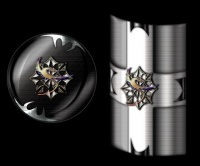 The Shield of Scholae Palatinae
The Shield of Scholae Palatinae
As often as the Leadership may protect a member, there will be times in which a member must retreat into the confines of their Clan. It is at these times the members of a Clan must stand strong and defend their allies and fellow members under their banner. When such occurrences happen, these members will stand as a solid defense upon which all opposition may fall… they are a shield to one another.
Two such variations are available to the members of the Royal Clan. A circular metal shield stands with an ornate design - two small crescents indent the circle upon opposite sides of the circumference. With the mark of the Clan centered between the crescents upon the center of the shield. The most noticeable trait is the color of the item, as it is entirely black with moderate silver lining in unique places. It straps upon the bearer’s off hand with two leather straps, giving it a unique fit to each wearer.
The second shield, a rectangular shield, with an ornate design - the shield is broken into four quadrants, each with a slight depression within them. With the mark of the Clan centered between the four quadrants upon the center of the shield. The most noticeable trait is the color of the item, as it is entirely silver with moderate black lining in unique places. It has two solid rings upon the back in which the bearer’s arm will slide through.
Sword
 The Sword of Clan Scholae Palatinae
The Sword of Clan Scholae Palatinae
As a Clan may provide greater defense within the defenses of the Brotherhood, a united Clan may become something more as well. With every member focused upon a single, attainable goal the wrath of such conviction may become an offensive onslaught of dedication, purpose, and activity. To represent the duality of a Clan, each member whom has strived to perfect their Clan’s art of death (or activity) will be awarded the honor of a Clan blade.
A standard short sword with intricate detail placed upon it by the smith, the blade extends a single meter, with a width of four inches that tapers into a triangular point. It is designed to be a single-handed blade, a hilt with a length of eight inches upon a vertical guard that is six inches in length; the pommel holds a diamond within a silver circle. The hilt is silver with a black, unknown thread wrapping gently about it at an even spacing. The blade has been etched with acid, the words: An eternity of darkness.
Armor
 Armor of Clan Scholae Palatinae
Armor of Clan Scholae Palatinae
Compounding of the defensive aspect of a Clan, the Bracers may only defend against the slightest of attacks. Thus, it does not entirely represent the limits a Clan will set to defend the heart of their most active membership. For this honor, the Clan will provide their member with an Armor that represents their station, clan crest, and dedication to the ideals and mission statement of the Clan. Rarely is this level of commitment seen within a Clan…
A metal cuirass, polished or stained pewter, with shining, silver pieces attached at the shoulders. An ornate design draws the eyes of observers to the center of the ceremonial armor, which bares the symbol of Clan Scholae Palatinae. Several gold accents have been added to offset the dark nature of the armor, increasing its value and aesthetics. While it offers no resistance against a lightsaber, the armor is retardant to minor blaster fire and errant blows from edged weapons.
Helm
 Krath helm of CSP
Krath helm of CSP
While a ring may embody the ideals of an Orders mutual affections and common endeavor, it simply does not represent another characteristic: Character. Upon completion of the hardest, most demanding trials, an individual may be asked by their Order to bear the Helm of the Order. This is not a leadership position, rather a position donned by the overall excellence and commitment to stimulate activity in the Order.
 Sith helm of CSP
Sith helm of CSP
Krath Order:
A circlet that rests upon one’s head, it is usually found in either silver or gold color and features a mounted gem of amethyst upon the wearer’s forehead. It is largely ceremonial, but some rumor it gives the wearer greater intuition. It is all currently speculation.
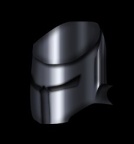 Obelisk helm of CSP
Obelisk helm of CSP
Sith Order:
A vicious mask that gives its enemies fright, the mask of the Sith is actually a helm fashioned after a demon. Though the type of demon or creature varies from Sith to Sith, the ideal remains the same with most masks sprouting pointed or twisted horns from the side of the helm. It is most generally wrought of either gold or a deep black iron; preference is left to the wearer.
Obelisk Order:
A helmet that covers the entire head and neck, this piece lacks the movable visor of some helms. Instead, it features slits for the eyes and mouth, surprisingly not giving up too much in visual acuity in its unique design. It is a thick metal, usually in shades of either black or dark gray. The top is flat, allowing cushion to fill in the void space on the inside so it does not shift in battle. A com-link may also be inserted into the design so it may be unnoticeable and practical in combat.
Consul Crown
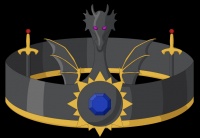 The crown of the Consul
The crown of the Consul
The Consul, as ruler of the entire clan is award with this finely crafted crown. Forged and sculpted out of pure gold, and black mandelorian iron, these compounds represent the ideals of the clan. The black iron is hard and solid, a solid foundation for the total control of the dark side. Gold is rare and a highly sought after metal, rich and decorated. This crown represents the best parts of the clan and has visual representations of the clans symbol found within.
The first thing that stands out is the dragon head and wings. The dragon is the widely associated symbol with the long standing House Acclivis Draco. This house was had strong ties to the Krath order, and this is represented by the ornate purple amethyst which makes up the dragons eyes. Underneath this is the Sun, a symbol associated with House Dorimad Sol. This house had ties with the Obelisk order, and this is represented with the large sapphire in the center of the silver sun. Finally on the outer sides of the crown are two blade hilts, representative of House Caliburnus. Although closed, Caliburnus has a deep history with the Clan and was placed here in memory of what it accomplished.
Proconsul Crown
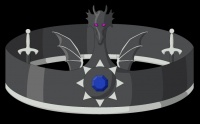 The crown of the Proconsul
The crown of the Proconsul
The Proconsul as secondary leader of the clan is anointed with a crown similar to the Consul’s. Instead of gold, the trim is outlined in pure silver. Many of the details of the Consul’s crown are left out of the Proconsul’s as well. There are less ornate gemstones, the dragon and swords don’t stand as tall, and the sun is less vibrant. This is symbolic that while the Proconsul still is over all of the parts of the clan, he does not rest as high as the Consul.
Quaestor Crowns
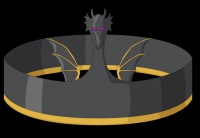 House Acclivis Draco QUA Crown
House Acclivis Draco QUA Crown
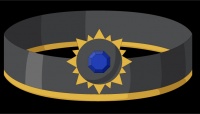 House Dorimad Sol QUA Crown
House Dorimad Sol QUA Crown
The crowns that are awarded to Quaestors are made of the same materials as the Consul. Because a Quaestor is the head of a house, only the symbol representing their respective house is used for their crown. For Acclivis Draco, only the dragon appears and for Dorimad Sol, only the sun.
Aedile Crowns
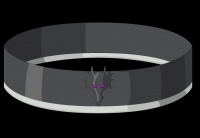 House Acclivis Draco AED Crown
House Acclivis Draco AED Crown
 House Dorimad Sol AED Crown
House Dorimad Sol AED Crown
Built of the ideas present in the other crowns, the Aedile crowns are constructed out of the same materials as the Proconsuls. As with the Quaestor’s, only the symbol associated with the Aedile’s house are used. Also much like the differences between the Consul’s and Proconsul’s crowns, the Aedile crowns are less ornate and more simplified then their Quaestor counterparts.
Honor Guards
Each Noble is assigned a designated maximum of individuals upon attainment of their rank, promotion, or demotion. These individuals will often begin as ambitious warriors hoping to ride the coattails of an individual Noble into infamy and glory! As a Noble progresses, they will often find their soldiers will increase in skill, power, and ability. Or, perhaps, they may acquire new individuals as they climb the social ladder to help them with their administrative duties or conquests.
If, for one reason or another, a member dies they will not be re-animated. Instead, a new raw individual will be assigned to replace that member of a Noble’s staff. This will often lead higher ranking Nobles to secretly attack the officials of a lower Noble, thus threats are not played out upon one another… but the lackeys of their Courts.
Fortifications
Parcel: Over a hundred different, unique parcels of land are available for nobles. The size and intricacies increasing with the growing fame and wealth of a Merit Noble. *Note: Additional details will come available with time*
Villa: A home usually found in the country, designated for the Upper Class. While each held a unique look, they may be broken into two separate classes. The more usual plan extended wings of rooms all opening onto a linking portico, which might be extended at right angles, even to enclose a courtyard. The other kind featured an aisled central hall like a basilica, suggesting the villa owner's magisterial role. The villa buildings were often independent structures linked by their enclosed courtyards.
Timber-framed construction, carefully fitted with mortices and tenons and dowelled together, set on stone footings, were the rule, replaced by stone buildings for the important ceremonial rooms. It is also suggested, though not necessary, that some rooms were fitted with glass windows and iron-worked grilles.
Mansion: A mansion is a large and stately dwelling house. In history, a mansion was an official stopping place on a State road, or via, where cities sprang up, and where the villas of provincial officials came to be placed. The English word "manse" originally defined a property large enough for the parish priest to maintain himself, but a mansion is no longer self-sustaining in this way. "Manor" comes from the same root — territorial holdings granted to a lord who would remain there— hence it is easy to see how the word "Mansion" came to have its meaning.
In comparison to a villa the mansion is much more civilized and often closer to secure trade routes. Its grandeur is well known and envied by those whom are often forced to consider their villa as a paradise. While not entirely defensible, it offers more protection than those below it.
Stronghold: A stronghold is often considered a mansion, but with a more secure defensive perimeter. It was often practiced to build a wall about one’s mansion, or home, to create a defensible perimeter - this was first practiced by stacking logs horizontally to an approximate height of ten feet. Later there would be adjustments that included spiked tops, barbed wire, and walkways for archers. While not as regal looking, it offers more protection than those below it.
Castle: A castle or military keep, was invented as a fortification not only for an individual, but those citizens aligned to a Noble. Some Castles will have either a Regal home or keep at its center, sturdy homes for it’s citizens and fortified walls to create a defense. Most of these structures are quite sturdy and will last through centuries of use and war. No two Castles will look alike, but each will remain a defensive strongpoint to a Noble’s base of power.
Citadel: A citadel is a fortress for protecting a town, sometimes with a castle in its middle. The term derives from the same Latin root as the word "city", civis, meaning citizen.
Citadels are most often used to protect a garrison or political power from the inhabitants of the town it is defending. They were designed to ensure loyalty from the town which they defended. It is the greatest defensive structure provided to Nobles and should not be looked down upon - this is the pinnacle of power within the Merit Noble structures.
Roster
Nobles
| Dossier# |
Name |
Merit Rank |
Merit Points
|
| 11 |
Arania Lawakiro Palpatine |
Archduke |
996
|
| 129 |
Natth a'Niel Palpatine |
Archduke |
901
|
| 180 |
Koskian 'Psyko' d'Tana |
Marquess |
493
|
| 3153 |
Cuchulain Darkblade Palpatine |
Viscount |
178
|
| 3160 |
Ric "Blade" Korbain |
Marquess & Judge |
463
|
| 3403 |
Sykes Jade |
Baron |
76
|
| 3491 |
RevengeX Palpatine |
Archduke |
863
|
| 3553 |
Voldemort |
Count |
229
|
| 3612 |
Phoenix Olkyssagh d'Tana Palpatine |
Grand Duke |
1560
|
| 3704 |
Xan Phraz-Etar Kaeth |
|
|
| 3883 |
Prajna Berkana |
Marquess |
323
|
| 4094 |
Tyno |
Marquess |
367
|
| 4583 |
Phantom |
Baroness |
9
|
| 4601 |
Dakari Kaeth |
Grand Duke |
1461
|
| 4867 |
Michael Arkarso |
Marquess |
302
|
| 5101 |
Thran Occasus |
Emperor and Duke |
503
|
| 6352 |
Luciferus "Scyrone" Leviathan |
Viscount |
185
|
| 6430 |
Solus Gar |
Baron |
27
|
| 8307 |
Kalak Ragnose |
Count & Judge |
260
|
| 8521 |
Draco Maligo |
Baron |
83
|
| 8955 |
Angelo Dante |
Duke & Grand Marshal |
738
|
| 8967 |
Yeldarb Vohokou |
Count |
208
|
| 9196 |
Robin Hawk |
Marchioness and Judge |
400
|
| 9761 |
Koryn Thraagus |
Viscount |
193
|
| 10106 |
Reiden Karr |
Baron |
82
|
Baronet
These pre-djk members do not yet qualify for the full Noble system, but their points are still being tallied.
| Dossier# |
Name |
Merit Points
|
| 4649 |
Ginnafae Delacor |
4
|
| 8409 |
Sauni Demai |
|
| 8488 |
Korroth Karn |
98
|
| 9280 |
Nihil Zayne |
85
|
| 9911 |
Lailoken |
20
|
| 10006 |
Tollo |
101
|
| 10228 |
Karean |
16
|
| 10310 |
RenNi Tyron |
4
|
| 10575 |
Oden Skychaser |
|
| 10646 |
Aesir |
22
|
| 10648 |
Faukes |
6
|
| 10659 |
jordon bonney |
|
| 10670 |
Stormgouge |
|
| 10681 |
DeadlyOwnage |
|
| 10694 |
Simo Navarr |
|
| 10700 |
Gelen Trayer |
|
| 10707 |
Karasumori |
|
| 10742 |
Sharundabald Abizandabar |
|
| 10760 |
Kia enialem |
|
| 10770 |
Callidous |
|
Honourary Nobles
By Decree of the Head of the Nobility, the following ex-members of Scholae Palatinae have been granted the right to keep their merit rank in respect of their contributions to and respectable reasons for departing from the clan.
| Dossier# |
Name |
Merit Rank |
Merit Points
|
| 205 |
Desio Predator |
Viscount |
100
|
| 326 |
Vally Darkstar Palpatine |
Viscount |
130
|
| 1540 |
Vail Aquillarum Unteminar |
Viscount |
165
|
| 1845 |
Exodius |
Baron |
92
|
| 3155 |
Lambow (Timbal) |
Count & Surface Marshal |
257
|
| 3776 |
Maximus Raidoner Mandalore |
Count |
213
|
| 3783 |
Xen'Mordin Vismorsus |
Viscount |
125
|
| 3821 |
Anga Salinas |
Viscount |
146
|
| 4520 |
Braecen Kaeth |
Grand Duke |
1710
|
| 4792 |
Lucien Kaeth |
Grand Duke |
1399
|
| 5951 |
Impetus M'Nar |
Duchess |
747
|
| 6677 |
Syphoc Rilkel Kaeth |
Viscount |
109
|
| 7370 |
Rasilvenaira Kaeth StormRaven |
Duchess |
572
|
| 7589 |
Brent "Archangel" Ligur Victae |
Marquess |
327
|
| 8003 |
Zeron |
Count |
224
|
| 8396 |
Xathia |
Viscount |
117
|
| 8405 |
Rayne |
Viscountess and Judge |
133
|
| 8734 |
Yzarc Rellik Kaeth |
Viscount |
110
|
| 9059 |
Tra'an Reith |
Viscount |
156
|
| 9119 |
Eludajae M'Nar |
Countess |
219
|